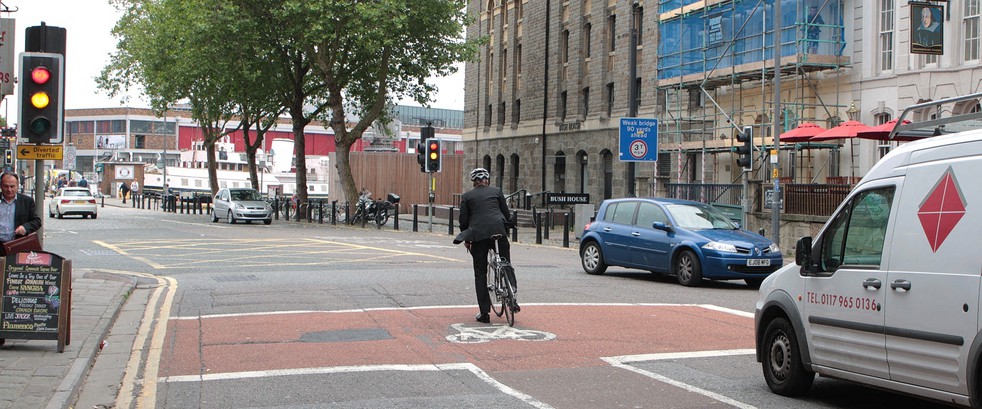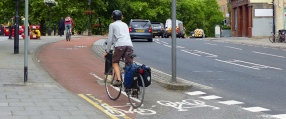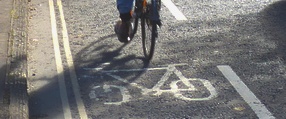Advanced Stop Lines (ASLs)

Advanced Stop Lines (ASLs) are a second stop line in advance of the normal stop line at signalised junctions. Within these two stop lines, there is normally a bicycle logo painted into the road.
ASLs create a waiting area for cyclists, and aim to increase pedestrian safety if there is a crossing area. ASLs are a relatively recent measure, and are becoming increasingly popular in towns and cities throughout the UK.
Effectiveness
ASLs provide a large benefit to both cyclists and pedestrians. They are a relatively cheap intervention, and work well to encourage sustainable transport modes.
Cyclists
A large benefit of ASLs is the increased time saving and comfort they offer cyclists, by allowing them to wait in front of motor vehicle traffic.
Where ASLs are used, the vast majority of cyclists are able to move to the front of traffic queues at traffic lights. Without an ASL, only two thirds of cyclists are able to reach the front of motor vehicle traffic queues.
Some motorists reduce the benefit of ASLs to cyclists by encroaching into the waiting area - this reduces cyclist comfort and safety. When a cyclist is waiting, around one third of motorists or motorcyclists encroach into the cycle waiting area, over the ASL.
Pedestrians
At signalised junctions, ASLs are very effective at reducing the number of cars stopping past the final stop line. It could be expected that ASLs would reduce the number of motor vehicles stopping past stop lines from 26% to at least 13%.
As a result, ASLs increase safety and comfort for pedestrians by ensuring motor vehicles are further away from the crossing area.
Safety effects
Currently, little is known about the safety effects of ASLs. There are few studies on ASLs, and research already existing is inconclusive. Despite this, many local authorities have continued to expand ASLs due to the benefits in comfort they offer to pedestrians and cyclists.
Advantages
- Make cycling more pleasant, and encourage cycling further on roads
- Cyclists move more quickly through traffic, by progressing to the front of traffic queues
- Cyclists are given priority, which allows them to turn right more easily
- Cyclists can wait in an area with less exhaust emissions
- Increases the visibility of cyclists to motorists, who can then give cyclists more road space
- Increases the distance between stopping motor vehicles and crossing pedestrian areas, which aims to make crossing more pleasant
- An advanced stop line can reduce the number of motor vehicles stopping within the pedestrian crossing area, which increases pedestrian safety.
- ASLs are a relatively cheap intervention for the benefits they provide to cyclists and pedestrians
Disadvantages
- The majority of motorists stop before the Advanced Stop Line, however some motorists stop after them, within the cycle waiting area.
- Reduces the amount of cars which can queue at traffic lights, which may reduce the efficiency of the junction for motor vehicles
Restrictions
- ASLs are only installed at signalised junctions
- ASLs are not used at signalised pedestrian crossings
- There must be enough space to allow for the ASL (normally 4-5 meters before the original stop line)
There's also some general restrictions to note for all schemes
Considerations
- A cycle lane does not have to be present
- Alternative road colours for the ASL waiting area (e.g. red) makes the stop line more visible, and may encourage motorists to stop before it
Advanced information
The findings here are based on Transport for London's (TfL) (Road Safety Unit, 2006) research into ASLs. This study is relatively robust, and is based in a UK urban environment which provides additional credibility. Safety effects of ASLs in this research were inconclusive.
Other research into compliance with ASLs are largely consistent with the above paper. Retting and Van Houten (2000) conducted a less robust study in Florida, United States. Their study suggests more positive effects of ASLs than the TfL study, with 25% of motor vehicles stopping in pedestrian crossings without an ASL, dropping to 7% when a 6.1 meter ASL was installed. Despite the weaker study design, the confidence in positive effects of ASLs was very high.
A further paper from Van Houten, Malenfant, McCusker (2002) examined conflicts at unsiganalised pedestrian crossings in Canada, and is not, therefore, immediately comparable to ASLs employed in the UK at signalised crossing locations. The paper is useful, however, for a third insight into driver compliance with ASLs, which showed a far greater proportion of motorists leaving at least a 3m distance in advance of the final stop line - typically from around 48% before ASLs to 77% after ASL installation.
References
Retting and Ron Van Houten (2000) Safety Benefits of Advance Stop Lines at Signalized Intersections: Results of a Field Evaluation. ITE Journal pp. 47 - 54.
Transport for London (2006) Behaviour at Cycle Advanced Stop Lines. (London Road Safety Unit, Research Summary No 6).
Van Houten, R., Malenfant J., McCusker, D., (2002) Advance Yeild Markings Reduce Motor Vehicle/Pedestrian Conflicts at Multilane Crosswalks with an Uncontrolled Approach. Transportation Research Record 1773 pp. 69 - 74.






